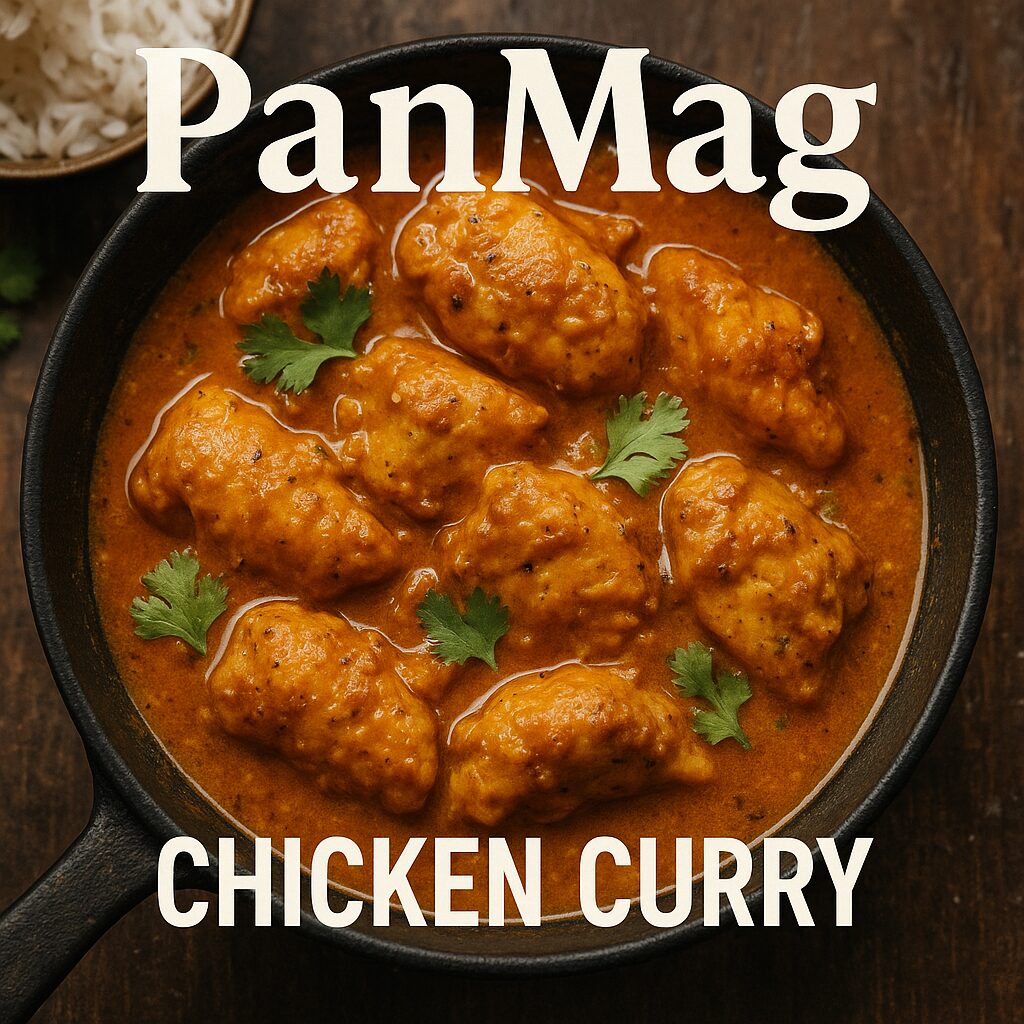Curry Recipe
Summary:
This curry recipe is special in my heart and always comforts and delights me. It also serves four people, making it perfect for a cosy family dinner or an intimate gathering of friends. When aromatic spices hit the hot oil, your kitchen fills with a mouthwatering aroma that lifts the spirit. Indeed, this dish is more than just food – it’s an experience of love and warmth in a bowl. Moreover, cooking it is surprisingly easy and deeply satisfying. Follow along as I share the story and secrets behind this beloved curry recipe, with personal tips to ensure you get perfect results every time.
Equipment:
- Large, heavy-bottomed pot or deep skillet with lid
- Cutting board
- Sharp knife
- Wooden spoon or spatula
- Measuring cups and spoons
Ingredients:
- 2 tablespoons cooking oil (vegetable oil or ghee)
- 1 large onion, finely chopped
- 3 cloves garlic, minced
- 1 tablespoon fresh ginger, grated
- 1½ pounds boneless chicken (preferably thighs), cut into bite-sized pieces
- 2 teaspoons curry powder (mild or hot, to taste)
- 1 teaspoon ground cumin (optional, for extra depth)
- 1 teaspoon ground coriander (optional)
- ½ teaspoon turmeric powder
- ½ teaspoon red chilli powder (optional, adjust for heat)
- 2 tomatoes, finely chopped (or 1 cup canned crushed tomatoes)
- 1 cup water or chicken broth (hot)
- ½ cup plain yoghurt, at room temperature (optional, for a creamier sauce)
- 1 teaspoon garam masala (optional, added at the end for aroma)
- Salt and black pepper, to taste
- Fresh cilantro leaves, chopped (for garnish)
Instructions:
- Sauté the aromatics: Heat the oil in a large pot over medium heat. Add the chopped onion (and a bay leaf or cinnamon stick if you have one for extra flavour). Sauté for about 6-8 minutes, stirring occasionally, until the onion turns soft and golden brown. This slow-cooking coaxes sweetness and builds a flavorful base for your curry recipe.
- Add ginger and garlic: Stir in the minced and grated ginger. Sauté for 1 minute, stirring constantly. Cook just until they release their fragrant aroma. Be careful not to let them burn, as burnt garlic can make the curry bitter.
- Bloom the spices: Now, sprinkle in the curry powder, ground cumin, ground coriander, turmeric, and chilli powder (if using). Stir well to coat the onions and cook the spices for about 30 seconds to 1 minute. You’ll notice the spices becoming fragrant – this step intensifies their flavours. However, do not fry them too long; keep everything moving so the spices don’t scorch.
- Stir in tomatoes: Add the chopped tomatoes to the pot and mix them into the spiced onion. Use your spoon to scrape up any browned bits from the bottom of the pan, as those carry lots of flavour. Cook the tomatoes for about 5-7 minutes, stirring often, until they break into a thick paste. The oil may start separating from the tomato-onion mixture when ready. Don’t rush this step, because well-cooked tomatoes give the curry a rich, savoury foundation.
- Cook the chicken: Add the chicken pieces to the pot along with a pinch of salt and pepper. Stir to coat the chicken in the flavorful masala base. Sauté the chicken for 3-5 minutes, until it changes from pink to white on the outside. It’s OK if it’s not fully cooked through at this stage. It’s OK if it’s not fully cooked through at this stage. Browning the chicken a bit now adds extra savoury flavour to the curry.
- Simmer with liquid: Pour in about 1 cup of hot water or chicken broth – just enough to mostly submerge the chicken and deglaze the pot. Stir everything together, scraping the bottom to ensure no spice is stuck. Let the curry come to a gentle boil, then reduce the heat to low. Cover the pot with a lid and let it simmer for 15 minutes. Meanwhile, you can stir occasionally to prevent sticking. Cooking slowly allows the chicken to turn tender and absorb all the beautiful spices. Your kitchen should smell heavenly by now!
- Check and finish the sauce: After 15 minutes, uncover the pot and check the consistency and seasoning. The chicken should be cooked thoroughly and very tender. If the curry looks too thick, add a hot water splash. Conversely, if it’s too thin, increase the heat to medium and let it simmer uncovered for a few more minutes to thicken. Now, taste the sauce and add salt if needed.
- Stir in yoghurt (optional): Turn the heat low and stir in the plain yoghurt for a creamier finish. (If you’re not using yoghurt, skip this step or stir in a few tablespoons of heavy cream or coconut milk.) Add the yoghurt slowly, stirring continuously, to prevent it from curdling. Let the curry simmer on low for another 2 minutes without boiling. This enriches the sauce and adds a lovely, subtle tang.
- Add final spices and rest: Sprinkle the garam masala over the curry and stir it. Garam masala is added at the end to release its aroma and add a flavour note. Turn off the heat and let the curry rest, covered, for 5 minutes. This brief rest helps all the flavours in the curry meld together perfectly.
- Garnish and serve: Lastly, stir in or top with freshly chopped cilantro. The vibrant green cilantro adds a fresh pop of colour and flavour. Your delightful curry is ready to serve! Ladle the curry into bowls and garnish with a few more cilantro leaves. Enjoy this curry hot with steamed basmati rice, warm naan bread, or roti. Every bite bursts with cosy, spiced goodness – a truly satisfying meal. I hope this curry recipe brings as much joy to your table as it does to mine.

Notes:
- Best chicken to use: This curry recipe turns out most juicy and tender when made with chicken thighs. Thighs stay succulent during simmering. However, if you only have chicken breast, you can still get great results – consider cutting the breast into slightly larger chunks and not overcooking them. For breast meat, you might even pan-sear the pieces for a couple of minutes (with a bit of extra curry powder and salt) at the start, then set them aside and add them back in the last few minutes of simmering. This way, they’ll stay moist.
- Adjusting spice level: Everyone’s heat preference for curry is different. Use a gentle curry powder and omit the chilli powder for a mild curry. On the other hand, if you love heat, you can add a chopped green chilli or increase the chilli powder. Add a pinch of cayenne pepper towards the end if you want it spicier – a little goes a long way.
- Flavour boosters: A curry recipe is only as good as its spices. A high-quality curry powder or an authentic garam masala will make a difference. Also, blooming the spices in oil (as we did) is the secret to unlocking that deep, rich flavour. Don’t skip that step. Additionally, adding a stick of cinnamon, a few cloves, or a couple of cardamom pods to the oil with the onions can impart an even more robust aroma (remember to remove any whole spices before serving).
- Vegetables and variations: This curry recipe is versatile. You can toss in some vegetables to make it a one-pot meal – for example, add diced potatoes or carrots at the same time as the chicken so they have time to cook until tender. Frozen peas are another great addition; stir them in during the last 5 minutes of simmering (they cook quickly). Alternatively, if you want to switch up the protein, you can use bone-in chicken pieces (they will need to simmer longer, about 25 minutes) or shrimp. (For shrimp or fish, add them in the last few minutes of cooking since they cook fast.)
- Make it creamy or dairy-free: The yoghurt in this recipe is optional. It gives a creamy tang, but you can leave it for a lighter curry. If you prefer a creamier, richer curry, stir in a few tablespoons of heavy cream at the end instead. For a dairy-free version, coconut milk works beautifully – replace the yoghurt and some of the broth with about 1 cup of full-fat coconut milk. It will create a luscious coconut curry. (If using light coconut milk, you might need to simmer a bit longer to thicken the sauce.)
- Serving and storage: Serve this aromatic curry with rice or flatbread to soak up all the sauce. Additionally, a squeeze of fresh lemon or lime on top right before eating brightens the flavours even more. Leftovers are fantastic because the flavours continue to develop, the curry might taste even better the next day! You can store leftovers in an airtight container in the fridge for 3-4 days. It also freezes well for up to 2 months; thaw and reheat gently on the stove. This curry recipe is an excellent make-ahead meal for busy weeks.
- Personal note: I hope this curry recipe brings your family as much warmth and joy as it has to mine. Happy cooking, and enjoy every savoury bite!
